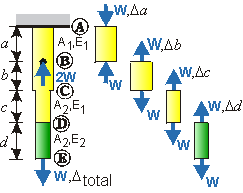Chapter 3 introduced an axial member of length L subjected to a constant tensile force P acting through the centroid of the bars constant cross-sectional area A. The material modulus E was uniform over the entire length. Since P, A and E are constant over the length of the bar:
![]()
Combining these equations gives the change in length of the bar:
The spring stiffness of an axial member of constant P, A and E over length L is: K = EA/L (P = KD).

